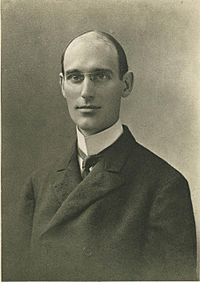Immigration Restriction League facts for kids
The Immigration Restriction League was an American group formed in 1894. It was started by Charles Warren, Robert DeCourcy Ward, and Prescott F. Hall. This group was against immigration and wanted to limit the number of people coming into the United States.
They believed that people from Southern and Eastern Europe were "racially inferior." This meant they thought these immigrants were not as good as people from Western and Northern Europe. The League felt that American traditions and culture were in danger. They worked to stop immigration from these areas. Their goal was to keep control for "Old Stock Americans," who were mostly white people whose families had been in the U.S. for a long time.
The League began in Boston. Soon, it had offices in New York, Chicago, and San Francisco. Many important scholars and wealthy people, especially from New England, joined the group. In 1896, a larger group called the National Association of Immigration Restriction Leagues was formed. Prescott F. Hall, one of the original founders, was its main leader until he died in 1921.
The League used books, flyers, meetings, and newspaper articles to share their ideas. They were the first American group focused on stopping immigration. After 1900, they hired people to influence lawmakers in Washington. They built a large group of supporters. This group included patriotic societies, farmers, lawmakers from the South and New England, and people who believed in eugenics. Eugenics was a harmful idea that some people were naturally better than others based on their race. The League closed down after Hall's death in 1921. They had worked hard to pass the Immigration Act of 1917.
Contents
What the League Wanted
Limiting Immigrant Numbers
On April 8, 1918, the League suggested a new law to Congress. This law aimed to greatly reduce the number of immigrants. It was called "An Act to regulate the immigration of aliens to, and the residence in, the United States."
The League wanted fewer immigrants from Southern and Eastern Europe. They wanted more from Northern and Western Europe. They believed people from these areas shared similar values.
Here's how they wanted to change the numbers:
| Region | Actually Admitted (before bill) | Admissible Under Bill (proposed) |
|---|---|---|
| Northern and Western Europe | 189,177 | 1,090,500 |
| Southern and Eastern Europe | 945,288 | 279,288 |
Higher Fees for Immigrants
The League also wanted to raise the fee for immigrants entering the U.S. They asked to increase it from two dollars to five dollars. This fee would not apply to citizens of the United States, Canada, Mexico, or Cuba.
The League said this money was needed to inspect and deport immigrants. The funds would help with:
- Enlarging immigrant stations (places where immigrants arrived).
- Improving services along the Mexico–US and Canada–US borders.
- Hiring more immigration inspectors.
- Expanding immigration office buildings.
The League also hoped this higher fee would stop poorer people from coming. They thought these people were less helpful to the United States.
Adding to Excluded Groups
A meeting in New York, the National Conference on Immigration, suggested adding more groups to those not allowed in. These included "imbeciles," "feeble-minded persons," and "epileptics." They also wanted to exclude people with "poor physique." The League believed these people were more likely to get sick.
The bill also wanted to fine steamship companies. These companies would be fined for bringing people who were considered "imbeciles," "feeble-minded," "insane," or "epileptics" into the U.S.
Stopping Illegal Landings
Before, transport companies only had to be careful when returning from Europe. This new bill ordered them to stop "undesirable aliens" from landing in the United States.
Deporting Public Charges
There was a law that allowed the deportation of immigrants. This applied to those who entered the U.S. illegally. It also applied to those who became "public charges" (meaning they needed public help) due to issues before they arrived. The bill stated that the transport company would pay half the cost to send these people back.
The Literacy Test
The Immigration Restriction League worked with labor unions. They both wanted a literacy test. This test would limit immigrants who were not well-educated. They believed these immigrants would lower wages. The test required potential immigrants to read at least 40 words in their own language.
Congress first passed a literacy bill in 1896. However, President Grover Cleveland stopped it in 1897. President William Taft also stopped a literacy test in 1913. Again in 1915, President Woodrow Wilson stopped a similar bill.
But in 1917, Congress passed the bill anyway, even though Wilson disagreed. This was part of the Immigration Act of 1917. It was the first time a literacy test was required for people to become citizens. The law said immigrants over 16 years old had to read 30 to 80 words in any language. However, this test did not work as planned. By the late 1910s, many people in Southern and Eastern Europe could read. Also, some of the immigrants the League worried about most were actually very literate.
Important Members
- George F. Edmunds, a founder
- John Fiske, a founder
- Frank B. Gary
- Madison Grant, vice president
- Prescott Farnsworth Hall, executive secretary
- Henry Holt, a publisher
- Joseph Lee, vice president
- Henry Cabot Lodge, a senator
- Robert Treat Paine, a founder
- James H. Patten, secretary in Washington, D.C.
- Nathaniel Shaler, a founder
- Francis Amasa Walker, vice president
- Robert DeCourcy Ward, a founder
- Owen Wister, a writer
See also
- Immigration reduction
- Opposition to immigration
- Immigration policy
- List of United States immigration legislation
- Dillingham Commission


